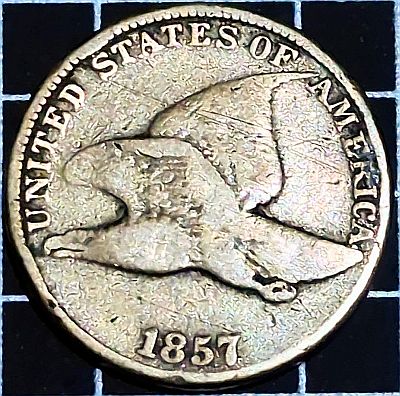A short but interesting issue of US cents
The Cent

As ubiquitous as the various forms of the “Lincoln Cent” are to anyone familiar with modern US currency, there were a number of designs before it. Even the long running Lincoln Cent has had five iterations. From 1793 to 1857, the cent showed a depiction of Lady Liberty (As previously seen here on a Brazilian coin). The date was below Liberty, with the reverse showing the country name, and denomination “ONE CENT” inside a wreath. From 1859 – 1909 (bringing us up to the Lincoln Cent), Liberty wore a Native American headdress. This has often been confused with being an image OF a Native American.
The Large Cent was increasingly unpopular by the 1840s and since the denomination was not legal tender (only silver and gold coins were legal tender in the United States), many merchants and banks refused to accept the coins. Others accepted the Large Cents at deep discounts. What was worse, by 1851, it was costing the Mint $1.06 to strike a Dollar’s worth of 1-Cent coins. A negative seignorage was at hand (seignorage is the profit the Mint makes between the cost of manufacturing a coin and its face value).
Obverse

The design of the Flying Eagle Penny was based on of the design of the Gobrecht Dollar (circulated between 1836 and 1839), the obverse side of the Flying Eagle Penny depicts an American Bald Eagle mid-flight. Legend holds that Gobrecht derived his original design from an eagle named Peter, which was apparently unusually tame and said to be fed by US Mint workers throughout the 1830s.
The country name is written around the top, with the date below. Although first minted in 1856, coins of this year were patterns and only a limited number were minted. Collectors generally aim for the 1857 or 1858 coins (with 17 and 24 million produced respectively). There were issues with production which meant the coin was retired in favour of the Indian Head Penny from 1859. These production issues also account for why most coins available today are in relatively low-grades or poor condition. Many worse than even my example.
Reverse

The reverse of the coin features the denomination “ONE CENT” on two lines in the middle, with an ornate wreath around. This was not greatly different to the earlier large cents, aside from the removal of the country name (which was now on the obverse). This design continued on to the first “Indian Head Cents” in 1859, although from 1860 those coins also included a shield at the top.
Due to the need to reduce costs, these “Small cent” coins are significantly smaller than the earlier “Large cent” coins. Large cents weight 10.89 grams with a diameter between 27 – 30mm. PCGS noted these were modelled after the British Penny denomination. However, the UK Penny was a 12mm silver coin up until 1800 (aside from the massive 1797 Cartwheel penny), seven years after the introduction of US cents. The size and copper composition is more like the half penny of the same era.
The flying eagle cent weighs 4.67 grams, with a diameter of 19mm. For some reason most pages don’t list the thickness of the coin, but I found this page on uCoin.net giving the thickness as 2mm. Mine seems closer to 1.9mm. The current US penny today still has a 19mm diameter, although now made of copper-plated zinc, and 1.5mm thick, the weight has dropped to 2.5g.


Leave a Reply